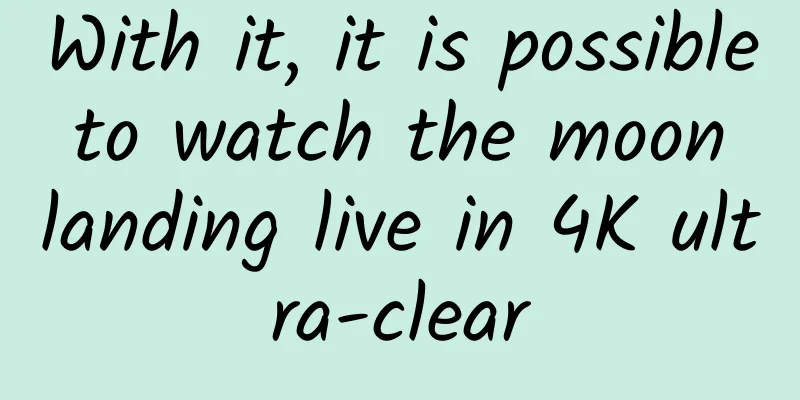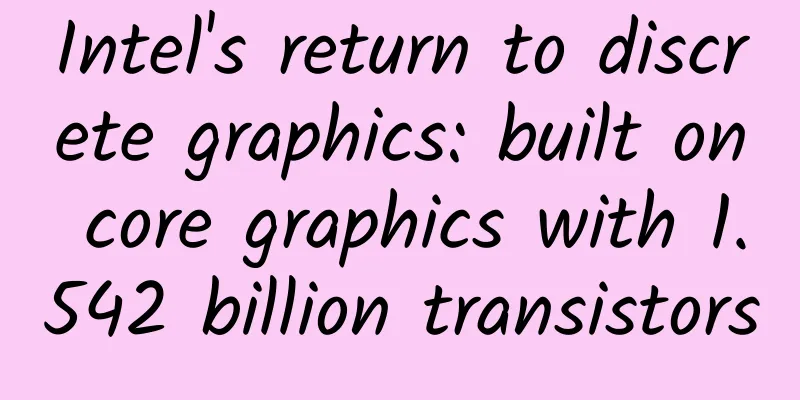With it, it is possible to watch the moon landing live in 4K ultra-clear

|
When you look up at the vast universe, have you ever wondered how astronauts and spacecraft on missions in space communicate with the ground? Will the long distance cause difficulties for data transmission? Traditional deep space communication: If you want a good signal, the antenna cannot be short Before introducing deep space communication, we must first understand the "wireless radio frequency transmission system" used in deep space communication. The so-called radio frequency transmission system refers to a device that can perform radio frequency communication. The radio spectrum used for space communication is mainly concentrated in 30MHz to 30GHz. This part of the spectrum covers part of microwave communication and shortwave communication, and is mainly used for satellite signal and television signal transmission. Spacecraft performing deep space missions generally use the 2.02 to 2.30 GHz frequency band for communication. With a wireless radio frequency transmission system, deep space probes can communicate with the Earth, including transmitting data. The problem with this communication method is obvious: data reception is slow. Take the New Horizons Pluto probe as an example. The data is transmitted back from 7.3 billion kilometers away from the earth. The downlink speed is only 1-4KB per second. It takes about 20 months to complete the data transmission. Now that we have understood the “wireless RF transmission system”, let’s return to deep space communication itself. In principle, deep space communication has two core elements: a transmitter and a receiver. The transmitter encodes the modulated information onto the electromagnetic wave, changing the characteristics of the wave and "embedding" the relevant data. The electromagnetic wave travels through space to the receiver, which demodulates and decodes the electromagnetic wave to obtain the sender's information. When using a wireless radio frequency transmission system, in order to improve the signal-to-noise ratio, a larger-diameter antenna is required. However, while improving the signal-to-noise ratio, it also means compressing the bandwidth, and the transmission rate per second will be limited. ILLUMA-T laser interrogation device installed on the International Space Station (Image credit: NASA) We cannot simply expand the antenna aperture. NASA's Deep Space Network uses a 70-meter antenna that weighs more than 7,000 tons and has a very large servo mechanism. Therefore, to increase bandwidth so that it can carry more data per second, we need to change the way we communicate. The Canberra Deep Space Communications Centre radio antenna in Canberra, Australia. Changing the way we communicate can carry more data. (Image credit: NASA) Want to watch 4K high-definition moon landing video? Laser communication can help you NASA has launched a revolutionary way to communicate data from space to the ground - the Laser Communications Relay Demonstration Project (LCRD). On December 7, 2021, the project entered the engineering verification phase. The experiment was conducted in a geosynchronous orbit at an altitude of 35,000 kilometers. The specific implementation plan is to send the STPSat-6 detector into orbit, use air-to-ground laser to connect two ground stations in Hawaii and California, and use the optical terminal on the International Space Station to receive and transmit data to verify the improved laser communication technology. The optical module of the LCRD demonstration project, used to emit infrared lasers (Image credit: NASA) If high-orbit laser communication can be successful, then laser communication can also be carried out at locations lower than the synchronous orbit. The LCRD demonstration project is NASA's first two-way optical communications relay satellite. Its predecessor was the Lunar Laser Communications Demonstration (LLD) launched in 2013. The latter verified the feasibility of space laser transmission, while the former increased the transmission speed of space lasers from hundreds of millions of bits to 1 billion bits, improving the bandwidth. The Lunar Laser Communications Demonstration Project, launched in 2013, verified the feasibility of Earth-Moon laser communications. (Image credit: NASA) NASA's laser communication relay demonstration can be said to have opened the door to future space communications, meaning that deep space communication technology will undergo drastic changes. For example, during the Apollo moon landing, the lunar spacecraft used a radio frequency system to transmit the moon landing status in real time, and the ground could only receive grainy black and white video. If laser transmission is used, 4K high-definition moon landing video can be uploaded back from the lunar orbit. In terms of transmission rate, sending and receiving data through invisible infrared lasers has a data transmission rate 10 to 100 times that of traditional spacecraft radio frequency communication systems. The 2013 lunar laser communications demonstration has demonstrated the ability to transmit data from the Moon to Earth at rates of hundreds of millions of bits per second, equivalent to more than 100 high-definition television channels simultaneously. The laser communication relay demonstration project is designed to achieve a rate of 1.2 gigabits per second. At this speed, we can upload a movie back from geostationary orbit in one minute. Compared with radio frequency systems, laser communication systems are smaller, lighter, and consume less power. These advantages, combined with higher bandwidth, can greatly help unmanned probes and astronauts explore various celestial bodies in the solar system. There is hope for live broadcast of moon landing, but there is still a long way to go The most practical significance of laser communication is that we have the opportunity to see the process of returning to the moon. The moon is about 380,000 kilometers away from us. For the speed of light, which is close to 300,000 kilometers per second, it can be said that there is no noticeable delay. In this way, the live broadcast of the moon landing will become clearer, which is equivalent to watching a high-definition live broadcast. Of course, space laser communication also has disadvantages. Unlike traditional spacecraft radio frequency communication, optical signals cannot penetrate clouds. This means that if space-based laser communication is to be carried out, multiple relay stations need to be established to avoid communication interruptions due to weather reasons. NASA chose two ground stations in Mesa, California and Akala, Hawaii because of the low cloud cover. Laser communication ground receiving device in Hawaii (Image credit: NASA) Moreover, laser communication is only in its early stages of development, so there is no need to worry about radio frequency communication being replaced. Laser communication can complement the deficiencies of radio communication and make the communication capabilities of deep space missions more powerful. Strictly speaking, deep space communication requires more than 2 million kilometers. NASA's tests in synchronous orbit and lunar orbit are only in the early stages of laser communication. Only by establishing a complete connection mechanism in the Earth-Moon system can it be extended to other deep space missions. NASA Laser Communications Demonstration Satellite (Image credit: NASA) When extending the communication distance, the problem of delay is difficult to avoid. For example, when sending astronauts to Mars for landing, the signal delay is about 4 minutes when Mars is closest to the Earth, and about 24 minutes when it is farthest from the Earth. Obviously, we must first ensure the stability of laser communication in transmission before we can deal with other effects caused by delay. Laser communication has a bright future, and real-time control is no longer a dream In terms of later applications, laser communications can also be extended to exploration missions of asteroids and more distant celestial bodies in the solar system. In addition to basic data transmission, 3D high-definition video signals can also be transmitted to the earth, so that scientists on the ground can control the landing device on the distant celestial body in real time, essentially realizing remote monitoring and control. This application scenario is suitable for unmanned lander surveys of the surface of extraterrestrial bodies, and can even use a combination of radio frequency and laser to conduct real-time exploration of underground caves on Mars. As the trend of celestial integrated information network approaches, traditional microwave communication methods are limited by bandwidth and speed, and it is increasingly difficult to meet the current multimedia business needs. Laser communication is also becoming one of the best solutions to replace microwave communication. Especially in large-scale aerospace projects, such as aviation transportation, space launch and other major applications, laser communication technology can also build high-dynamic satellite laser networking and expand the scope of space-based information services. Laser communication technology can also build high-dynamic satellite laser networks to expand the scope of space-based information services. (Image credit: NASA) It is worth mentioning that laser signal transmission is also used between China's Beidou satellites and ground stations. Related high-speed communication experiments have been completed, and the speed is faster than 5G networks. In the near future, my country will have the world's first laser communication network covering the entire globe, and the large-scale application of satellite Internet is also coming. Recently, news about the development of a new generation of heavy rockets was also disclosed by CCTV and other media, which means that my country may be able to achieve manned lunar landing in the near future. As laser communication technology continues to mature, it is believed that it will also be applied to the field of manned lunar landing, realizing real-time live broadcast of China's lunar landing. References: [1] Laser Communication Relay Demonstration Project Home Page: https://www.nasa.gov/mission_pages/tdm/lcrd/index.html [2] NASA'S NEXT STEP IN OPTICAL COMMUNICATIONS https://www.nasa.gov/sites/default/files/atoms/files/lcrd_fact_sheet.pdf [3] Zheng Yunqiang, Liu Huan, Meng Jiacheng, Wang Yufei, Nie Wenchao, Wu Junxia, Wei Tingting, Wei Sentao, Yuan Zhanchao, Wang Wei, Xie Xiaoping. Research progress and trends of air-based laser communication and key technologies [J/OL]. Infrared and Laser Engineering: 1-15 [2021-12-17]. |
<<: It's not an allergy! Many people have been infected after "testing positive", doctors remind -
>>: The 2022 rumor list is out, have you believed it?
Recommend
60 episodes of Ankasment Jung's Analytical Psychology Theory and Practice Workshop online course video
Ann Casement Jung Analytical Psychology Theory an...
How much does it cost to develop a Dalian food mini program? What is the quote for developing Dalian Food Mini Program?
The main factors affecting the price of mini prog...
The DNA in your body is everywhere, and some of it may be the evil plan of tumor cells
Author: Liu Tiantong Tsinghua University School o...
Special: 30 pictures, full of orange
On the land of China From the stunning mountains ...
World Economic Forum: Driving Effective Transformation of Energy Systems 2020 Report
The report comprehensively considers the current ...
In Madagascar, a country full of amazing species, the giant lemur calmly looked at me
The Republic of Madagascar is located in southeas...
It took me 300 million yuan to learn the secrets of information flow copywriting!
I am different from other optimizers because I wo...
Xiao Fei Da Xia Training Camp Episode 9 Baidu Cloud Download
Resource introduction of the ninth phase of the L...
Wearing a display on your body: The black technology in woven fabrics is so cool!
"Luo Ji spent 185 years in a dream. When he ...
Real physics terms: Atomic bombs have nothing to do with atoms, and hydrogen bombs have little to do with hydrogen
In scientific research, scientists create proper ...
Fengyun Media Douyin live streaming practical course: 3 days to blow up the live broadcast room and 7 days of stable natural flow gameplay [Video course]
Fengyun Media Douyin live streaming practical cou...
Zhihu ranking algorithm and traffic diversion method
The following content is the editor’s exclusive e...
Understanding the RxJava threading model
[[182175]] RxJava is a very popular framework at ...
Pregnant women eating hawthorn may cause miscarriage? What prejudices do you have about hawthorn?
gossip In autumn and winter, there is a kind of f...
Domestication of millet: "Millet" tells the story of a grain of millet
Millet is the most important food crop in ancient...









